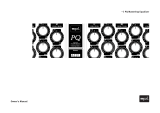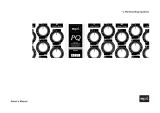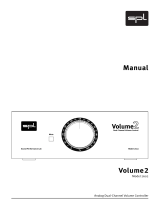
11
Control Elements
Prop. Q -Button (blue)
Thankstothisbutton,eachofthe10lterbandscanbesetfromConstant-Qmode(light
off) into Proportional-Q mode (button lights up).
Proportional-Q mode / Constant-Q mode
Each frequency band consists essentially of two fully parametric equalizers: one for cons-
tant Q mode and one for proportional (or variable) Q mode, selectable per band. The PQ
istherstequalizertoofferbothmodes,endowingitwithdoubleequalizationpowerfor
demanding corrective (Constant-Q) and creative applications (Proportional-Q).
In constant Q mode, the selected bandwidth remains unaffected by the amplitude set-
ting, making it the best choice for corrective applications (e.g. to eliminate unwanted
frequencies). In proportional Q mode, the amplitude is reduced as the bandwidth is rai-
sed and vice versa. With the smallest bandwidth setting, the maximum amplitude re-
aches +/- 20 dB, while it is reduced to +/- 2.8 dB with the broadest bandwidth setting.
The Proportional Q mode is better suited for creative, sound-shaping applications, as a
bandwidth-related amplitude allows for sensible, musically suggestive operation – with
raising bandwidths, higher amplitudes are increasingly less useful.
Channel Switch
You can activate or deactivate the right or the left channel with the two centrally located
orange illuminated buttons.
Auto Bypass
Tobeabletomakeanobjectivejudgmentoftheprocessedmaterial,itisbestnottohave
to be toggling between the original and processed signals by yourself, but rather have it
done automatically. Plus, the fact that you do not have to move from the sweet spot and
can concentrate better on the music to optimally assess the processing is a huge advan-
tage. The Interval control determines the time that needs to elapse before the compressor
toggles between the processed and unprocessed signals. Hard left is the shortest set-
ting. To increase the interval, turn the knob clockwise.
Link
The PQ Mastering Equalizer has been designed as a completely independent two-channel
equalizer and can be used to process two different mono signals at the same time. Ne-
vertheless, you can also easily process a stereo signal. If you activate the Link function,
settings LF, LMF, MF, MHF, HF On/Off and Prop. Q on both sides are collectively controlled
bythebuttonsofoneside.Thisallowsyoutotoactivateordeactivatealterbandorthe
Q-Characteristic on both sides of the equalizer with the use of a button. Amplitude, 1/4
Gain, Frequency and Bandwidth are excluded in this process. According to the factory
setting, the right side controlls the left side in Link mode. However, this setting can be
adjustedtoyourindividualworkinghabits.Ifyoupressthechannelswitchofoneofthe
channelsuntilitstartsashing,fromthenonthissidewillcontroltheotherchannel.






















